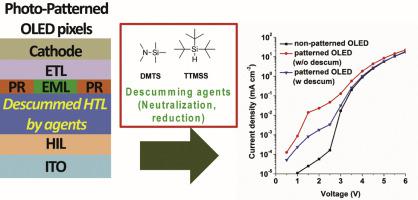当前位置:
X-MOL 学术
›
Microelectron. Eng.
›
论文详情
Our official English website, www.x-mol.net, welcomes your
feedback! (Note: you will need to create a separate account there.)
Descumming fluorous solution for photolithographic patterning of organic light-emitting diodes
Microelectronic Engineering ( IF 2.6 ) Pub Date : 2020-04-01 , DOI: 10.1016/j.mee.2020.111324 Jongchan Son , Han Young Shin , Yu Min Choi , Seung Gun Chae , Chunhee Park , Byung Jun Jung , Jin-Kyun Lee
Microelectronic Engineering ( IF 2.6 ) Pub Date : 2020-04-01 , DOI: 10.1016/j.mee.2020.111324 Jongchan Son , Han Young Shin , Yu Min Choi , Seung Gun Chae , Chunhee Park , Byung Jun Jung , Jin-Kyun Lee

|
Abstract Orthogonal processing is a photolithographic patterning method using fluorous solvents and highly fluorinated photoresists; it has shown potential as a unique patterning protocol that can form high-resolution structures while minimizing damage to the thin films of organic electronic materials. In this study, we adopted the technique to the photo-patterning of 15 μm half-pitch organic light-emitting diode (OLED) pixels on a 4,4′,4»-tri(N-carbazolyl)triphenylamine (TCTA) thin film that forms a hole-transporting layer (HTL). However, the device patterned using the highly fluorinated materials system showed a lower driving voltage and reduced efficiency compared to the non-patterned device. This problem was presumed to be caused by the attachment of strong acid molecules generated from the photo-patterning process and residues of the highly fluorinated photoresist to the TCTA surface. To remove this scum layer and to restore the performance of the TCTA, a solution-based rinsing process was devised and performed onto the TCTA layer by adding a trace amount of (dimethylamino)trimethylsilane (DMTS) and tris(trimethylsilyl)silane (TTMSS) to a fluorous solvent. As a result, the driving voltage and efficiency of the patterned OLED device were restored to similar levels to those of the non-patterned reference. Observation of the patterned TCTA layer with an atomic force microscope (AFM) gave an idea that the morphology of the patterned TCTA film was changed to be similar to that of the pristine TCTA film after the solution-based rinsing process. Furthermore, X-ray photoelectron spectroscopy (XPS) also verified that the solution containing descumming agents reduced the fluorine residue on the TCTA surface. This result demonstrated that the solution-based descumming process is an effective approach to increase the device performance during the photolithographic patterning of OLEDs to which typical dry etching-based descumming may not be applied.
中文翻译:

用于有机发光二极管光刻图案化的脱脂氟溶液
摘要 正交加工是一种使用含氟溶剂和高度氟化的光刻胶的光刻图案化方法;它已显示出作为一种独特的图案化协议的潜力,可以形成高分辨率结构,同时最大限度地减少对有机电子材料薄膜的损坏。在这项研究中,我们采用该技术在 4,4',4»-三(N-咔唑基)三苯胺 (TCTA) 薄膜上对 15 μm 半间距有机发光二极管 (OLED) 像素进行了光图案化形成空穴传输层(HTL)。然而,与非图案化器件相比,使用高度氟化材料系统图案化的器件显示出较低的驱动电压和较低的效率。这个问题被认为是由光图案化过程中产生的强酸分子和高度氟化光刻胶的残留物附着在 TCTA 表面引起的。为了去除该浮渣层并恢复 TCTA 的性能,设计了一种基于溶液的冲洗工艺,并通过添加痕量的(二甲氨基)三甲基硅烷(DMTS)和三(三甲基甲硅烷基)硅烷(TTMSS)对 TCTA 层进行冲洗到含氟溶剂。结果,图案化的 OLED 器件的驱动电压和效率恢复到与未图案化参考的相似水平。用原子力显微镜 (AFM) 观察图案化的 TCTA 层可以得出这样的想法:在基于溶液的冲洗过程后,图案化的 TCTA 膜的形态改变为类似于原始 TCTA 膜的形态。此外,X 射线光电子能谱 (XPS) 还证实含有去渣剂的溶液减少了 TCTA 表面上的氟残留。该结果表明,基于溶液的除渣工艺是一种在 OLED 光刻图案化过程中提高器件性能的有效方法,而典型的基于干法蚀刻的除渣工艺可能不适用。
更新日期:2020-04-01
中文翻译:

用于有机发光二极管光刻图案化的脱脂氟溶液
摘要 正交加工是一种使用含氟溶剂和高度氟化的光刻胶的光刻图案化方法;它已显示出作为一种独特的图案化协议的潜力,可以形成高分辨率结构,同时最大限度地减少对有机电子材料薄膜的损坏。在这项研究中,我们采用该技术在 4,4',4»-三(N-咔唑基)三苯胺 (TCTA) 薄膜上对 15 μm 半间距有机发光二极管 (OLED) 像素进行了光图案化形成空穴传输层(HTL)。然而,与非图案化器件相比,使用高度氟化材料系统图案化的器件显示出较低的驱动电压和较低的效率。这个问题被认为是由光图案化过程中产生的强酸分子和高度氟化光刻胶的残留物附着在 TCTA 表面引起的。为了去除该浮渣层并恢复 TCTA 的性能,设计了一种基于溶液的冲洗工艺,并通过添加痕量的(二甲氨基)三甲基硅烷(DMTS)和三(三甲基甲硅烷基)硅烷(TTMSS)对 TCTA 层进行冲洗到含氟溶剂。结果,图案化的 OLED 器件的驱动电压和效率恢复到与未图案化参考的相似水平。用原子力显微镜 (AFM) 观察图案化的 TCTA 层可以得出这样的想法:在基于溶液的冲洗过程后,图案化的 TCTA 膜的形态改变为类似于原始 TCTA 膜的形态。此外,X 射线光电子能谱 (XPS) 还证实含有去渣剂的溶液减少了 TCTA 表面上的氟残留。该结果表明,基于溶液的除渣工艺是一种在 OLED 光刻图案化过程中提高器件性能的有效方法,而典型的基于干法蚀刻的除渣工艺可能不适用。











































 京公网安备 11010802027423号
京公网安备 11010802027423号